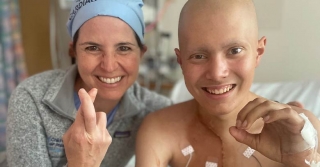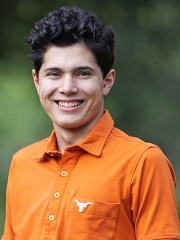Synovial Sarcoma: Callan’s Story
Published on
Published on
“Inoperable.” That was the first evaluation that 16-year-old Callan and his parents, Laura and Chas, received when seeking treatment options for Callan’s rare tumor. He was diagnosed in January 2022 with synovial sarcoma, a soft-tissue cancer that afflicts fewer than two in a million people in the U.S. per year, with approximately half of cases occurring in adolescents and young adults. The Austin-based family immediately began a nationwide search of pediatric oncology programs. At the second evaluation, they heard it again: inoperable. Then they heard it a third time.
 Callan with his lead surgeon Stephanie Fuller, MD.
Callan’s tumor was located in his chest, compressing his lung and near critical nerves and blood vessels, and it was larger than a grapefruit. One institution said that proton radiation, which uses a very precise beam, could not be administered so close to the heart. Most gave Callan little chance for survival, suggesting hospice care.
Callan with his lead surgeon Stephanie Fuller, MD.
Callan’s tumor was located in his chest, compressing his lung and near critical nerves and blood vessels, and it was larger than a grapefruit. One institution said that proton radiation, which uses a very precise beam, could not be administered so close to the heart. Most gave Callan little chance for survival, suggesting hospice care.
“With the help of research,” says Laura, “we knew surgery was the only way to survive synovial sarcoma. We just needed to find the right group of surgeons.” So they kept looking.
“The fact that both Laura and I grew up with doctors in our families, and we know about the practice of medicine, and that synovial sarcoma is so rare that no one sees a lot of cases — that’s why we persisted,” explains Chas. “And we had examples of people we knew getting multiple opinions and not taking ‘no’ for an answer.”
One program offered a surgical plan but outsourced the radiation treatment. The family’s next opinion came from Children's Hospital of Philadelphia (CHOP). And at CHOP, they heard: We can perform this surgery. We can offer proton radiation. Here’s a comprehensive treatment plan.
After Callan received several rounds of chemotherapy at hospitals near the family’s Texas home, they flew to Philadelphia in March and met with many of the clinicians who would be on Callan’s CHOP care team, including pediatric oncologist Theodore Laetsch, MD, who leads the Very Rare Malignant Tumors Program; radiation oncologist Christine Hill-Kayser, MD; and surgeon Peter Mattei, MD, who later enlisted surgeon Stephanie Fuller, MD, who specializes in cardiothoracic surgery.
The chemotherapy that Callan had undergone had shrunk the tumor, and the team was guardedly confident of a successful treatment plan. A month later, the family relocated to Philadelphia, and Callan began 25 daily doses of proton radiation in collaboration with Penn Medicine at the Roberts Proton Therapy Center.
During this period leading up to the surgery, the family would regularly have what Chas calls “true-to-fashion CHOP meetings,” in which the entire care team would be present. “Everyone is in the room together, down to the anesthesiologist,” explains Laura. “Instead of us running around to meet everyone, you have a patient coordinator who draws everyone together. They all make time for each other and respect each other. The communication is remarkable.” Adds Chas: “Maybe CHOP thinks that happens everywhere. It doesn’t.”
Laura points out that, for a case such as Callan’s, every member of the care team needs to be knowledgeable about rare symptoms and diseases. “The people doing the imaging, inserting an IV — all those pieces are important. Some hospitals have a major oncologist, but without all those components, you can’t treat a complex case. Inserting a central line for Callan — I can’t tell you how difficult it could be, but it was no big deal at CHOP.”
In June 2022, Callan underwent a 10-hour surgery. The complicated procedure required six surgeons. It involved a 6-inch artery graft, removing Callan’s right lung’s upper lobe and removing his right jugular vein. Two-thirds of the way through, the tumor was removed. It weighed 3 pounds.
A year later, after much steady recovery and ongoing physical therapy but no major setbacks, Callan is a high-school graduate poised to be a fine arts major at the University of Texas at Austin.
 Callan will begin studying fine arts at UT-Austin in fall 2023.
“I truly believe we did what couldn’t be accomplished elsewhere,” says Dr. Fuller, Callan’s lead surgeon. Now Laura and Chas’s mission is to ensure other institutions understand this disease is treatable with the right comprehensive team. They want to ensure that other families facing a synovial sarcoma diagnosis fully understand the options.
Callan will begin studying fine arts at UT-Austin in fall 2023.
“I truly believe we did what couldn’t be accomplished elsewhere,” says Dr. Fuller, Callan’s lead surgeon. Now Laura and Chas’s mission is to ensure other institutions understand this disease is treatable with the right comprehensive team. They want to ensure that other families facing a synovial sarcoma diagnosis fully understand the options.
After Callan’s diagnosis, “I spent weeks searching for specific information and like-cases for Callan,” says Chas. “I collected data to help my son. But then it became something bigger. I realized I had visibility into more cases than anyone in the world.” As a data analyst and consultant, Chas knew he could build a database to show treatment paths and survivorship protocols. So he set up a Facebook page called “Synovial Sarcoma Families.” People fill out a 37-question survey to become a member. The database includes hundreds of cases and continues to increase.
In addition, Laura and Chas created a fundraiser with the goal of raising $1 million to establish the Spence Family Synovial Sarcoma Fund. The money raised will support the creation of a clinical registry at CHOP to leverage and formalize the vast amount of data the family has collected. The family also wants to help CHOP develop a synovial sarcoma tumor board, which will bring together a multidisciplinary team of national experts to discuss cases. After the family jump-started the fund with their own six-figure gift, they have received donations exceeding their dollar goal.
“Their contribution is amazing,” Dr. Laetsch says of the family’s work. “Both their effort in organizing this rare patient community and their fundraising will be invaluable to advance care for future patients with synovial sarcoma by bringing together experts from multiple disciplines to share best practices and learn from each other. Additionally, the data set we will assemble, again, thanks to their organization and fundraising, will be one of the largest, if not the largest, in synovial sarcoma and a key resource to advance the field.”
Dr. Fuller agrees: “They are going to make us more collaborative with our colleagues to think outside the box and work harder to connect the right team for exceptional care. Much like putting together pieces of a puzzle, we are able to explore every area of expertise — combining medical and surgical knowledge, traditional and novel therapies, and adult and pediatric specialists to go beyond what is typical treatment. This will create new pathways and better therapy through collaboration for our patients. Ultimately, we want everyone to beat the odds.”